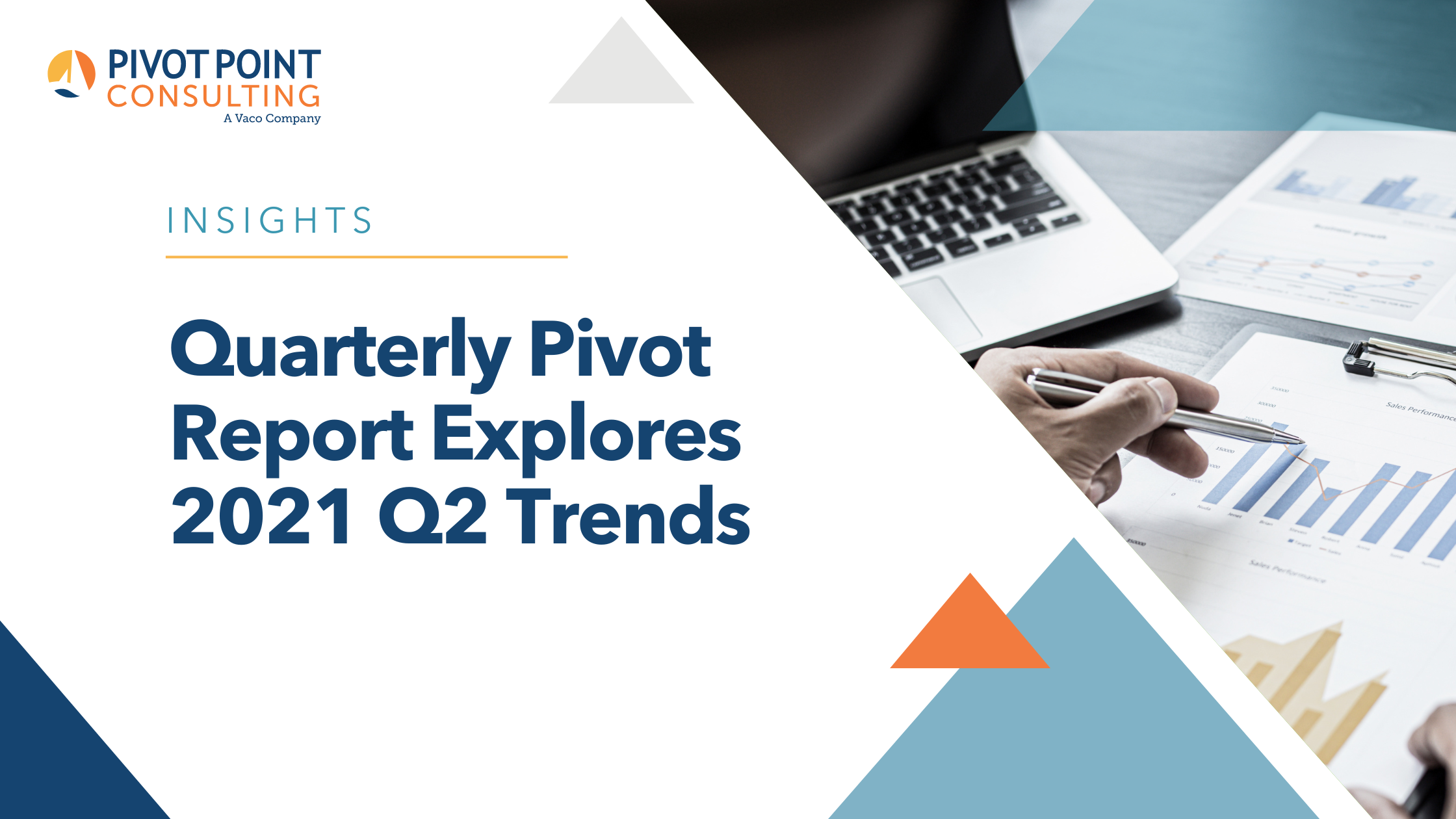The latest edition of the Quarterly Pivot provides insight into 2021 Q2 trends. In it, you’ll learn what’s ahead for managed services, mergers and acquisitions, virtual care, data analytics and EHRs.
NASHVILLE, TENN. APRIL 07, 2021 — In keeping with its dedication to remaining ahead of developing trends in healthcare, Pivot Point Consulting, 2020 Best in KLAS Overall IT Services Firm and a healthcare IT consulting leader, today released the latest edition of its Quarterly Pivot report. This new report, which examines trends that will affect providers and payers in Q2 of 2021, offers insights on diverse topics including managed services, mergers and acquisitions, virtual care, data analytics, and electronic health records (EHRs).
“The last 12 months have been some of the most tumultuous in recent history, especially in the healthcare industry,” said Rachel Marano, Pivot Point Consulting Managing Partner and Co-Founder. “Many segments of the sector have seen 5-10 years’ worth of changes implemented in that time and are struggling to determine what is next. Our intention with this report is to offer proven, evidence-based guidance to help healthcare IT leaders make better, more-informed decisions that will help them bring some welcome stability to their organizations and help them plan for the future.”
Trends identified in the Q2 Quarterly Pivot are highlighted below. To access the full Q2 Quarterly Pivot report, including additional insights and resources from Pivot Point Consulting’s subject matter experts, like innovations to know and important industry events, download the full report here.
Managed Services
- Ongoing Patient IT Support. The growth of self-service capabilities for patients means patients will be working through a myriad of applications, portals and devices. Further, these will all require a high degree of customer service and support. Providers must be prepared to offer and scale that assistance.
- COVID-19 Vaccination Demand Management. As vaccinations become more widely available, health systems’ ability to handle increased call volumes and the influx of support needs for both patients and healthcare staff will continue to drive the need for direct or overflow managed services options.
- Managed Services Return on Investment. In the past, support for IT (such as non-functioning passwords), patient-facing applications, EHRs and other clinical applications were handled by separate teams. The post-COVID landscape, however, points to a need for a blended support model that covers all these areas under a single umbrella. This is a model that is often best handled through managed services.
M&A
- Deals Heat Up. All indicators are 2021 will be a busy year for M&A activity for providers, payers and vendors. After a pause in 2020, many organizations are back in growth mode. Additionally, they’ll be seeking to make up lost ground in 2021.
- Rationalization ROI. Increased M&A activity is driving the C-suite to look strategically at service, application and vendor rationalization. Many health systems will be proactively reviewing applications and solutions across their current environments and building rationalization models into the growth strategy “playbooks.”
Virtual Care
- Amazon’s Healthcare Expansion. Amazon’s expansion into healthcare continues at a blistering pace. Recently Amazon Care announced it will expand its virtual care to other companies and Amazon employees in all 50 states. The result is Amazon has become a major player across a large continuum of care delivery in just two years. Traditional providers will need to prepare for this new competition.
- Additional Telehealth Funding. After reviewing public input, the FCC proposed to launch the second round of its $250 million COVID-19 telehealth program. Healthcare organizations should begin looking now at how they can best take advantage of this new cash infusion.
Analytics & AI
- Artificial Intelligence/Machine Learning. AI and ML tools are playing more of a critical role in driving insights from non-structured data. AI in particular is delivering insights that might not be readily obvious to clinicians or administrators. AI and ML tools will continue to take advantage of these capabilities and their ability to drive predictive outcomes.
- Strong Data Governance. As organizations make business and clinical decisions based on their data, it is critical to have an interdisciplinary team of experts to help determine policy, procedure and process, as well as to ensure that decisions prioritize patient care first. This will become a greater priority in Q2.
- On-Demand Reporting as a Service. Many organizations are just starting to set up Centers of Excellence for on-demand reporting and overall data analytics. Using an on-demand model that focuses on reporting as a service will be used to stand up a robust team.
EHR
- Tech Giants Become More Embedded. Companies such as Google, Amazon and Apple are presenting ninnovative ways for patients to manage components of their health directly. The drive toward full data integration will continue to provide catalysts for these tech companies to aggregate data, making health data portability more of a reality.
- Driving Toward Patient Self-Service. The near-instantaneous move to virtual care as a result of COVID-19 created new demands on scheduling and care delivery, as well as associated EHR changes to support these needs. Many of these changes are likely to remain in place and encourage more patient self-service.
- Health Records and Health Plans. EHR vendors and health plans will continue to partner as means of streamlining prior authorizations for members. These authorizations will increasingly be delivered at the point-of-care rather than as a post-visit activity, speeding fulfillment while helping ensure referrals remain in-network.
“While the effect COVID-19 has had on health plans, providers and patients has been profound and undeniable–with vaccine availability expanding rapidly–the overall expectation is a shift to whatever the new ‘normal’ will be,” Marano said. “Health plans and providers should plan accordingly. Pivot Point Consulting is ready to help in all of these areas.”
The Quarterly Pivot report is published each quarter. It features trends watch, innovations to know about, upcoming industry events and thought leadership resources.


